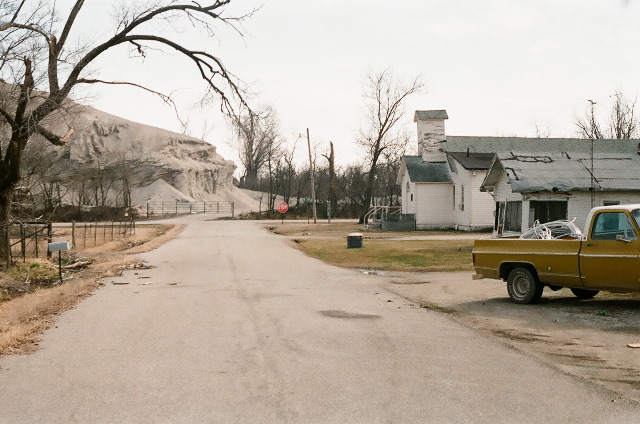Nestled in the upper east corner of the state of Oklahoma is the site of America’s most toxic town. One that the government declared unsuitable for anyone to inhabit and later destroyed a majority of the buildings.
Abandon Picher, OK. Copyrighted by Small Town Photography © pic.twitter.com/8sShRL56wF
— SmallTownPhotography (@SmallTownMO) August 27, 2015
Dotting the ends of the streets and surrounding fields of this town rich with industrial American history are massive toxic piles of white and brown material.
These piles are made up of the remnants of a huge network of mines that occupied Picher, Oklahoma and the surrounding land.
Day 17 #dyk facts on the Freeman-Bible case you won't find anywhere else between @HLNTV #HellInTheHeartland episodes. Before being a ghost town, Picher OK was a happening place w 6 movie theatres & 2 dozen saloons. Some still proudly call themselves as Chat Rats (see chat piles) pic.twitter.com/b8Y4utHRC0
— Jax Miller (@RealJaxMiller) June 19, 2019
Picher was known for its mining operations and was a huge industrial producer of lead and zinc ore. At the height of its boom, the town of Picher was the top producer of lead-zinc mining and was responsible for more than half of all the lead and zinc used during the first world war.
Picher, Oklahoma between 1918 and 1922. Nearly half of all bullets fired in WW1 were mined from Picher. #history pic.twitter.com/ZOlwCxmR0I
— Okie History (@OkieHistoryPics) June 3, 2016
Skelton Mines – Picher, OK… pic.twitter.com/SLCgJ39ckz
— Angel Muñiz (@areasvellas) July 18, 2018
At one point, there were nearly 20,000 people working in and around the town.
But, all that mining came at a very high cost…
Extraction Town. @bldgblog on Picher, Oklahoma and its collapsing lead mines https://t.co/FNoLun5FDb pic.twitter.com/bakca5tUOU
— MAS Context (@MASContext) October 15, 2017
The remains of a processing plant amidst the chat piles in Picher, OK. @jwhittalTWN @MMillaire_MM pic.twitter.com/zvNSuUGwVE
— Mark Robinson (@StormhunterTWN) May 20, 2015
During the mining boom, massive trailings from the mine (also called chat) were left in huge piles around the area – and very close to neighborhoods and businesses.
Ghost town // picher, Oklahoma pic.twitter.com/kz8zbZPXIv
— Derek Livingston (@GorillaPhotog) June 6, 2020
Picher, OK was declared uninhabitable due to the mines the town once serviced. (Photos: http://t.co/2iaRGKtxJv) pic.twitter.com/838PGatmVa
— Oklahoma Facts (@okfacts) April 27, 2015
Because the toxic mining residue was not handled properly and simply just placed wherever they could find a spot, it seeped into the groundwater and poisoned the residents.
That was only the beginning of the problems for Picher.

Remediation efforts were attempted after the mines closed in 1967 and continued for the majority of the next 20+ years. However, the expansive mining in the subterranean area beneath the town created unstable foundations for buildings and as the mines laid there empty, they started to collapse.
This uses to be a grocery store in picher Oklahoma, back in the 40- 60 today picher is a ghost town, pic.twitter.com/7rrCC2snv7
— Overton Lee Usrey (@usreyoverton) February 17, 2019
Picher is part of the larger Tar Creek Superfund site as designated by the EPA. One mine cave-in from this site claimed nine homes.
After decades of trying to remediate the toxic leaching of lead into the groundwater and soil, Congress approved a mandatory relocation program for all inhabitants and the state followed up with a program of their own.
https://twitter.com/johndavidreece6/status/1161950647182229505?s=20
abandoned city. picher// Oklahoma pic.twitter.com/KEbapGjySW
— alyssa (@attentionseeka) April 3, 2015
At the turn of the century, the United States Census recorded just 1,600 people living in Picher, Oklahoma…and before the decade was up, that number was down to 20.
Picher, Oklahoma: The Biggest Environmental Disaster You've Never Heard Of pic.twitter.com/JTJtTt3f1U
— N*i*c*k*i (@Nickiflorida) January 19, 2018
In 2009, the few remaining residents voted to dissolve the local school district and months later the post office closed down. Just four years later, the state officially dissolved the municipality.
https://twitter.com/FreakyTheory/status/492149726654234625?s=20
It had been discovered that even 10 years after the Superfund was enacted for Picher, that over 60% of children in the town had been suffering from ongoing lead poisoning – which can severely damage their brain functions.
I'm watching a documentary on Picher, Oklahoma. I'd read about what happened there, but never saw photos. It's NUTS. pic.twitter.com/WUQXNDnBtC
— Pascalle Lepas 🪼 (@lepas) October 31, 2015
Picher is just one of a handful of localities world-wide that have been deemed so toxic and dangerous for living creatures that the government has forced evacuations due to mining contamination.
Took the drone down to Picher, Oklahoma. I've been shooting this abandoned town for about 10 years now but this is my first time from the air! pic.twitter.com/8yF99EOJ1E
— Nathan Papes (@NPapes) October 26, 2020
The town is left with only a few residents who have refused to leave (less than 10).
Even in recent years, the government has continued to try and remediate the horrific environmental damage at the Tar Creek Superfund site. In 2019, the federal government along with the state of Oklahoma and local Native American tribe, the Quapaw Nation, put together a plan to accelerate the cleanup.
Watch a documentary of the town below.



